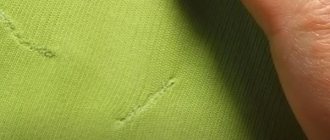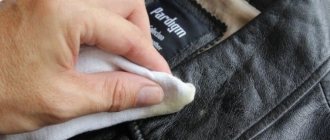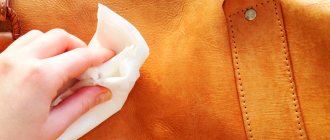Bologna is a synthetic fabric with a waterproof coating.
Due to these properties of the material, bolognese jackets are highly popular and in demand. They are lightweight, available for purchase in most stores, and reliably protect their owners from rain and wind. However, bologna has a significant drawback - vulnerability to cuts, burns and other damage. If a sleeve or other part of the jacket gets caught on a sharp, protruding object or touches a cigarette, a hole will inevitably appear in the clothing. There are some nuances in how to seal a leather jacket so that no traces of damage remain visible.
How to fix a jacket?
Of course, you can turn to the craftsmen for help if the item is quite expensive, the hole is too complex, or if you are not confident in your abilities. But if you decide to get down to business on your own and bring your favorite outerwear into perfect shape, then doing this with our tips will not be difficult. Let's first look at the reasons why jackets most often tear:
- It can tear if it gets caught on a nail or sharp object.
- The hole was caused by burning, either from a cigarette or a hot object.
- The seams came apart due to extreme stretching.
Based on the type of damage, you need to choose a special remedy for repair. So, with a jacket you can do the following:
- Sew up.
- Seal with glue.
- Use reflective tape and braid.
- Sew on a patch or stripe.
- Cover with zipper and other decor.
Next, we will look at each method in more detail.
Universal repair method
Methods for masking holes and defects depend on the type of jacket fabric. Duspo, taslan, leather, and taffeta are most often used for sewing outerwear. They have different densities and structures, so repair methods will differ in each specific case.
Features of repairing jackets made of different materials:
- Leather. It is recommended to use thick fabric or pieces of leather to seal the holes. They are sewn on by machine or glued with rubber glue - Moment, Hvat, Special Glue.
- Duspo. Mostly sports jackets are made from thick woven fabric. Therefore, patches with inscriptions that are glued or sewn on are ideal for sealing cuts.
- Taslan. Dense material with grosgrain weave is frayed, as it contains reinforcing nylon threads. Therefore, to mask defects, it is better to use chevrons based on hot-melt adhesive. If the seams diverge, the jacket is ripped open and bias tape is placed on the wrong side.
A patch is one of the simplest ways to reanimate jackets with defects. Depending on the size of the tear, scratch or hole, adhesive-based stripes and chevrons, braid, bias tape, appliqués or zippers are used as patches. If you do not know how to sew, then a suitable piece of fabric can be attached to Moment glue or non-woven fabric.
Experts always pay attention to the fact that if the hole on the jacket is in the place where the zipper would be appropriate, then you can safely use a design technique. To give a torn jacket a completely new, more interesting look, you can safely use various zippers, decorative rivets and buttons.
We suggest you read: How to properly care for a stainless steel sink?
How to sew up a hole in a jacket?
This method is suitable for sealing small holes and slits, as well as if the product is torn along the seam. For these purposes, you will need a thin long needle, thread to match your outerwear and basic sewing skills. Here is the necessary sequence of actions:
- We measure a double thread up to the elbow and thread it into a needle. We tie a knot at one end of the thread.
- If you need to sew up a small hole, then you need to pierce the jacket from the wrong side, and then carefully sew the product.
If you need to sew a thing along the seam, then there are 2 methods, choose the most suitable one for yourself:
- For the first method, you need to rip the product open from the inside in order to quietly sew it up with bologna. Then you will need to sew the hole made from the inside out.
- If you are not ready to tear the lining, you will have to sew the fabric from the outside. To do this, bring the needle through the wrong side and sew the seam in parallel lines. Most often, the places where tears occur are in the armpits, and there the seam is usually not visible, so you can act boldly.
- When sewing along a seam, you need to start doing this 1-2 centimeters before the start of the tear. You should darn directly along the seam itself, that is, along the thread holes, in order to darn the item as unnoticeably as possible. At the end of the action, we hide the knot from the inside.
Removing stubborn stains
In addition to various defects, down jackets and other types of jackets often have stubborn stains that are difficult to remove with ordinary means at hand. In this case, time-tested tips will come to the rescue:
- Using regular laundry soap, you can remove fresh greasy stains. The greatest effect is achieved if you thoroughly soap the problem area and leave it overnight. After this, all that remains is to wash the jacket in the usual way.
- If your outerwear is made of light-colored fabric, then you can use ammonia. Contaminated areas are wiped with a small cloth. You need to be careful, since applying ammonia to a clean fabric may simply discolor it.
- Regular table salt has proven itself to be effective in the fight against greasy stains. The secret of this procedure is that the contaminated areas need to be rubbed with salt until they completely disappear.
- You can often see specific stains with a greasy sheen appear on the collar, pockets and cuffs. Baking soda and vinegar will help deal with them. A small amount of the product should be applied to a cotton pad and wiped over problem areas.
- Old, stubborn stains can be removed well with dishwashing detergent. In this case, the soap composition should be dropped onto the stain itself and rubbed well until foam forms. In this state, outerwear should be left for 4 hours and then rinsed under running water.
- The most common and effective is bread crumb, which copes well with various types of stains. Treat the contaminated areas with a piece of bread and leave the jacket for 5 hours. After this time, the product should be washed by hand with the addition of powder or other detergent.
How to seal a hole in a down jacket?
Sealing a down jacket is practically the main method of how to get rid of a slit without visible marks. This method is quite effective and easy to use. For these purposes, you need to purchase a special glue that will not lose its properties at the first rain. The following types are suitable:
- Rubber or acrylic glue.
- Glue “Moment 88” or “Crystal”.
- "Second".
Detailed instructions for use:
- If threads stick out in the cut or there are burnt areas, then carefully cut them off.
- We bend the edge of the cut and drip a little glue onto it.
- Press tightly to the other edge and hold for several seconds.
- Ready. You can start using the item within 24 hours.
Rules of care
Once you have succeeded in sewing up your Bolognese jacket, you need to take proper care of it so that it lasts as long as possible. The main rule remains that before washing and other procedures you must study all the recommendations on the label. To prevent the jacket from losing its shape, it is best to wash it by hand.
Specialized detergent compositions, as well as care products for synthetics, have a gentle effect. To remove all stains, the jacket can be soaked in a pre-diluted product for 45 minutes (it all depends on the degree and nature of the dirt). The surface of the material can be rubbed with a sponge or brush, but it must not be rubbed.
To prevent the jacket's filling from bunching up into separate bundles, it cannot be washed in a washing machine. Indeed, in this case, there is a high probability that creases and folds will appear on the surface of the item, which are very difficult to eliminate. In rare cases, you can resort to the help of technology, but you need to choose a delicate mode.
After washing, do not wring out outer clothing, but allow it to drain over a bathtub or basin. For gradual drying, it is better to choose a well-ventilated room, but away from direct sunlight and electrical appliances. A small jacket can be hung on hangers, but large items based on synthetic padding are best laid out on a clean terry towel, allowing them to dry in a horizontal position.
How to fix a jacket using a patch?
This is a fairly popular method of repairing not only outerwear, but any clothing in general. What will we need and what will be the procedure? You need to acquire the following materials:
- Transparent rubber adhesive.
- Patch.
- Scissors.
- Cotton swab.
- Acetone.
Many manufacturers include a bag with a fabric sample in the clothing set. If it is available and fits in size, then you can use it. If not or it is too small (the patch should be about 1 cm larger than the slot), you can try cutting a piece of fabric from the most inconspicuous area of the jacket or simply choosing a material that is as similar in color and structure as possible. After purchasing all the necessary materials, you need to do the following:
- Soak cotton wool in acetone and wipe the surface of the jacket and patch to degrease them.
- Apply glue around the perimeter of the cut and the patch, making sure to coat the corners especially well so that they do not stick out after gluing.
- Wait about 4 minutes for the glue to harden slightly.
- Mark the place where you will glue the patch and apply it very precisely. You will have only one attempt for this, since with this method the patch cannot be further adjusted.
- Press it as hard as possible onto the bologna and hold for about 5 seconds. In this case, it is not the holding time that is important, but the force of the pressing itself.
There are also special patches with an adhesive base; to use them you do not have to buy or use glue. If you have one, then do the following:
- Place the patch under the tear, adhesive side up.
- Carefully adjust the entire structure so that it looks neat and beautiful.
- Iron with a hot iron until completely bonded.
You can also use non-woven tape or regular plastic film to adhere the patch to the fabric. This is done like this:
- To glue the patch on the inside, you will have to cut the lining to get to the hole.
- Connect the torn edges of the bologna, pulling them towards each other, and place interlining or a piece of film on top.
- Then attach the patch and iron it with a hot iron through the fabric or a special ironing mesh.
- The film should melt, gluing both surfaces together.
Polyethylene or non-woven fabric
Polyethylene or non-woven fabric will help to disguise the cigarette hole. For repairs, you will additionally need a patch or piece of fabric that matches the color and texture of the bologna.
How to seal a bolone jacket at home:
- the jacket is laid out on the table;
- the lining is cut at the site of the defect;
- interlining is applied from the front part to the hole;
- a fabric patch of the same size is placed on top;
- cover with a cotton cloth and press the heated iron for 15-20 seconds.
We suggest you read How to tie a washcloth with your own hands
If you wish, you can repair a bologna jacket with non-woven fabric based on hot-melt adhesive. It is glued using the same principle as fabric stripes.
To ensure that the hole is sealed, the interlining is cut so that it overlaps the edge of the hole by at least 7-10 mm.
How to cover a hole with applique?
Patches, applications and stickers ideally mask all visible flaws in a product and help update old items. You can choose any suitable sticker to suit your taste and use a creative approach. The main thing is that it fits into the overall look, for example, for children's clothing you can choose a patch with cartoon characters, and to repair men's clothing, you need a strict patch to match the product. So, once you've found the perfect patch, it's time to attach it to the fabric. You can do this in two ways:
- Sew on.
- Glue it.
If you have a fabric overlay, it should be sewn to the bologna. This is done like this:
- We trim the edges of the ugly hole and cut off all excess.
- On the inside, glue or sew any piece of fabric.
- Apply the patch on top so that it completely covers the slot.
- Carefully sew along the edges.
- Ready!
If you use a thermo-adhesive badge, then everything will be easier and faster with it. Follow these instructions:
- Repeat points 1, 2 and 3 from the previous list.
- Cover the badge with some cloth.
- Heat the iron to maximum power and apply it to the patch through the fabric for literally 5 seconds.
- That's all! A fashionable and reliable patch is glued on.
Braid, applique or ribbon as a patch
If a bolognese jacket has defects in the form of scratches or holes, sewing accessories will help correct the situation. The following are used as patches:
- Braid is a narrow woven or fabric strip that is used for decorative finishing and repair of clothing. It can be used to decorate scratches or cuts, and strengthen seams on the front or back side of the jacket. Differs from decorative tape in increased strength. The braid is made of cotton, linen or wool.
- Appliques are decorative elements made from scraps of fabric, adhesive interlining, decorative buttons, rhinestones, etc. This method of repairing jackets is suitable for creative people who can create entire compositions from pieces of different materials.
- Bias binding is a fabric strip cut on a bias, which is used for edging parts. Suitable for filling holes in the hem area of a sleeve. To prevent the trim from being noticeable, the trim is sewn onto both sleeves at once.
- Chevrons and stripes are decorative elements intended for finishing or repairing clothing. For those who have never held a needle in their hands, adhesive-based fabric patches are suitable. In fabric and accessories sales centers you can purchase original patches in the form of cartoon characters, motivational inscriptions, patriotic symbols, etc.
To disguise holes on bolognese jackets, decorative buttons, reflective stripes, and stripes with sequins are additionally used.
How to make a patch on a jacket in 5 minutes:
- sew the hole manually with thread of any color;
- attach the adhesive-based patch;
- Place gauze or cotton cloth folded in several layers on top;
- place a heated iron on top for 25-30 seconds.
Under the influence of high temperature, the hot-melt adhesive will become liquid and absorb into the jacket fabric. This patch holds tightly and does not come off even after machine washing.
Renewing a down jacket at home
Among other things, you can get creative and show your imagination. To cover awkward holes and update a down jacket, you can use a lot of things, for example, buttons, snaps, rivets, embroidery, pebbles, sequins or other decor. They can be attached to pieces of fabric and then sewn onto the jacket. You can create any pattern - either symmetrical, on both sides of the garment, or single.
As you can see, all of the above methods are quite simple and do not require a lot of effort and money. With these simple methods you can give a “second life” to torn outerwear yourself, without turning to specialists for help.
Share on social media networks:
Sealing leather products
Despite the high quality of such outerwear, it is also subject to some damage that can be disguised at home. Most often in this case, universal glue “Moment” is used.
If the damaged area is on the sleeve, then you need to turn the jacket inside out and tear off the lining a little. The jacket should be straightened in order to correctly cut a small piece of fabric, the diameter of which will correspond to the existing hole. Fixing glue must be applied both to the patch itself and to the defect site. The adhesive composition should be fixed (this procedure takes no more than 30 minutes).
When the material dries, you can apply another layer of glue. Only now can the patch be glued to the jacket. Place a press on top of the area to be treated and leave it for 3 hours. When the item dries, you need to check whether the edges of the attached patch are coming off. If everything is fine, then you can safely sew up the lining.
Decorative elements
Of course, sewing up a hole in a jacket is quite simple, but you can give your preference to a simpler option - masking the damaged area with original embroidery, sticker or even appliqué. But this method has one drawback - colorful patterns, chevrons and monograms do not look appropriate in all places.
You can give your preference to traditional embroidery, which is first applied to a separate piece of fabric, leaving an allowance of 0.7 cm on each edge. After carefully ironing the workpiece, it can be safely sewn to a jacket or coat.











